The UK's Civil Aviation Agency (CAA) has revealed that almost 15,000 ghost flights left the UK between March 2020 and September 2021. Ghost flights are empty flights that airlines operate to hold on to airport slots by ensuring they meet minimum usage targets.
Almost 15,000 UK ghost flights
As the COVID pandemic spread worldwide in March 2020, airlines increasingly flew empty flights - dubbed 'ghost flights' - to hold on to their airport slots.
Official figures from the UK's CAA show that 14,472 ghost flights departed the UK from March 2020 to September 2021. This amounted to an average of 720 ghost flights each month.
Under-secretary of the Department for Transport, Robert Courts, said,
"Departing flights may operate with a low number of passengers for a range of reasons. To reduce the risk of airlines operating environmentally damaging empty or near-empty flights, legislation includes an enhanced justified non-utilisation provision, meaning that airlines will not be required to operate slots where markets are substantively closed to passenger traffic."
Ghost flights were defined as flights with no passengers or less than 10% of passenger capacity. Even after 80/20 'use it or lose it' slot rules were suspended, ghost flights continued on a considerable scale and persisted when slot rules were partially reinstated to 50/50.
Anna Hughes, from the climate campaign group Flight Free UK, said,
"If more than 14,000 empty flights took off from UK airports when there was no requirement to retain landing slots, how many more will have taken off since? Preventing planes from flying empty should be an easy win for policymakers and the climate."
It is important to note that the data included international flights but not domestic flights. Ghost flights operated from 32 airports across the UK, with Heathrow Airport topping the list at 4,910 ghost flights.
The Department of Transport added,
"We acted swiftly [during the pandemic] to prevent empty aircraft needing to fly to retain their slots. However, some flights may operate with low passenger numbers for a whole range of reasons, including carrying key workers or vital cargo."
Five hundred ghost flights a month from October to December
The official CAA figures cover the pandemic up to September 2021. However, according to data obtained by The Guardian, a significant number of ghost flights continued in the final quarter of 2021.
Tim Johnson, from the Aviation Environment Federation, said,
"Information [on ghost flights] is hidden from public view, with airlines avoiding scrutiny by claiming the data is proprietary. No doubt airlines fear reputational damage, but the public and consumers should be informed. UK airline average occupancy grew significantly in the last six months of 2021... but this hasn’t altered the number of ultra-low occupancy flights in our skies each month."
An average of 500 ghost flights per month left UK airports between October to December. Data shows that Heathrow, Aberdeen, Manchester, Stansted, and Norwich airports were the worst offenders.
Will ghost flights continue?
As the aviation industry continues its recovery, ghost flights appear to be less of a concern. However, there is no guarantee that further disruptions to the industry could not force airlines to continue operating empty flights.
Simple Flying looked at whether we should be worried about ghost flights continuing in the future. Factors that could influence the number of ghost flights include the emergence of new variants and regulatory changes.
What are your thoughts on the practice of operating ghost flights? Let us know in the comments.
Source: The Guardian



